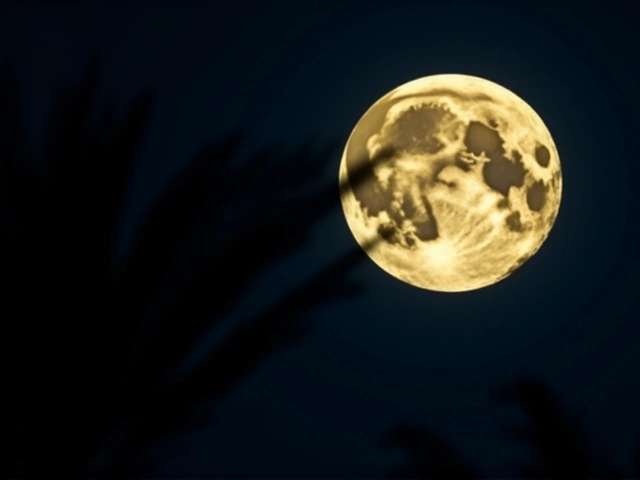
The supermoon of November 5, 2025, will be the closest and brightest lunar event Arizona will see this year—no telescope required. At 6:19 a.m. MST, the full moon will reach peak illumination, hovering just NASA’s calculations confirm this is when the moon hits perigee, its closest point to Earth at 221,817 miles. That’s nearly 30% brighter and 14% larger than a typical full moon, turning the night sky into a glowing spectacle visible to the naked eye across the state.
When and Where to See It
The moon will rise at 5:31 p.m. MST on Wednesday, November 5, low on the eastern horizon, giving skywatchers in Phoenix, Tucson, Flagstaff, and beyond a dramatic ‘moon illusion’—when the moon looks enormous near the horizon, even if it’s not actually bigger. It’ll climb to its zenith at 12:50 a.m. on Thursday, November 6, then sink toward the western sky, setting at 8:21 a.m. MST. That means you’ve got over 15 hours to catch it, from twilight through dawn.
According to Time and Date, the timing aligns perfectly with Arizona’s time zone, making it one of the most reliably scheduled celestial events of the year. The U.S. Naval Observatory, which has been tracking lunar cycles since 1830, confirms the exact moment of full moon in Eastern Time (8:19 a.m. ET), which translates cleanly to 6:19 a.m. MST. No time zone confusion here.
Why It’s Called the Beaver Moon
Native to North American folklore, the name ‘Beaver Moon’ isn’t just poetic—it’s practical. The Old Farmer’s Almanac, first published in 1792 and the go-to source for traditional moon names since the 1930s, ties this November full moon to beavers building dams and stockpiling food before winter. Trappers historically hunted beavers during this month for their thick, waterproof pelts, and the name stuck.
But here’s the twist: the Royal Museums Greenwich notes scholarly disagreement. Some historians argue the name comes from Indigenous communities setting traps during this season, while others insist it’s purely about the beavers’ own behavior. Either way, the name endures. Other traditional names for this moon include the ‘Digging Moon,’ ‘Deer Rutting Moon,’ and ‘Frost Moon’—each a quiet nod to nature’s seasonal rhythm.
A Year of Celestial Wonders
Arizona’s skywatchers have already had a stellar 2025. October brought the Orionid meteor shower, sightings of comets Lemmon and Swan, and even a temporary asteroid moon—2025 QD—that briefly orbited Earth. Now, the November supermoon caps off a season of cosmic drama. Tiffany Acosta, a journalist with AZ Central, noted in her reporting that this supermoon feels like a reward after a month of celestial fireworks.
And it’s not just amateurs who are excited. Celebrity astrologer Kyle Thomas, who advises high-profile clients, told Good Morning America that this supermoon carries emotional weight: “It’s a moment to ground yourself and strengthen your spirit for the winter ahead.” Whether you believe in astrology or not, there’s something undeniably calming about watching the moon swell in the sky—especially when it’s this close.
What Makes a Supermoon?
Not every full moon is a supermoon. It takes a perfect alignment: the moon must be full at the same time it reaches perigee—the point in its elliptical orbit where it’s closest to Earth. The difference between perigee and apogee (its farthest point, about 252,000 miles away) is why this event stands out. The moon’s orbit isn’t circular; it wobbles slightly, so each supermoon varies in proximity. This November’s 221,817-mile distance makes it the closest of 2025, beating the previous supermoon in March by over 2,000 miles.
NASA’s Lunar Reconnaissance Orbiter has mapped these changes in detail. The brightness increase isn’t just perception—it’s physics. More sunlight reflects off the lunar surface when it’s closer, and atmospheric scattering makes the low-hanging moon appear even more vivid. That’s why the best views come right after moonrise, when the moon is still low and the contrast against the darkening sky is strongest.
What’s Next?
The next full moon? December 4, 2025—the last of the year. It’ll be the ‘Cold Moon,’ a name rooted in the deepening chill of winter. But it won’t be a supermoon. After that, the next supermoon won’t come until January 2026, and even then, it won’t be as close as this November’s.
For now, Arizona residents are being urged to step outside, put away the phones, and just look up. No filters. No apps. Just the quiet glow of a celestial neighbor that’s never been this near in 2025.
Frequently Asked Questions
Why does the supermoon look bigger near the horizon?
This is called the ‘moon illusion’—a psychological effect where the moon appears larger when near trees, buildings, or mountains because your brain compares it to familiar objects. It’s not actually bigger; NASA confirms the angular size doesn’t change. But the effect is real and stunning, making moonrise the best time to view it.
Will weather affect visibility in Arizona?
Yes. Clear skies are essential. While Phoenix and Tucson typically have low cloud cover in November, mountainous areas like Flagstaff may see higher humidity or early snow. The Phoenix New Times advises checking local forecasts the day before. Even a thin layer of clouds can diffuse the moon’s glow, reducing its impact.
Is this the closest supermoon ever in Arizona?
No, but it’s the closest of 2025. The record for Arizona was set in November 2016, when the moon was 221,524 miles away—about 293 miles closer than this year. Still, supermoons this close happen only about once every 14 months on average. Don’t expect another this near until 2028.
What’s the difference between a supermoon and a blue moon?
A supermoon is about distance—it’s a full moon at perigee. A blue moon is about timing—it’s the second full moon in a single calendar month. They’re unrelated. The next blue moon in Arizona won’t occur until August 2026. This November moon is super, not blue.
Can I photograph the supermoon with my smartphone?
Yes, but results vary. Use manual mode if available, lower the ISO, and avoid digital zoom. For better shots, point your phone at the moon just after sunset, when the sky is still slightly blue—this creates contrast. Apps like NightCap or ProCam help. But for true detail, a DSLR with a telephoto lens is ideal.
Why do moon names vary between cultures?
Different Indigenous groups across North America had their own lunar calendars based on local ecology. The ‘Beaver Moon’ is an Algonquin term popularized by the Old Farmer’s Almanac, but other tribes called it the ‘Frost Moon’ or ‘Slaughtering Moon.’ The Royal Museums Greenwich archives show over 30 variations across Native, European, and colonial sources—each reflecting regional survival rhythms.





